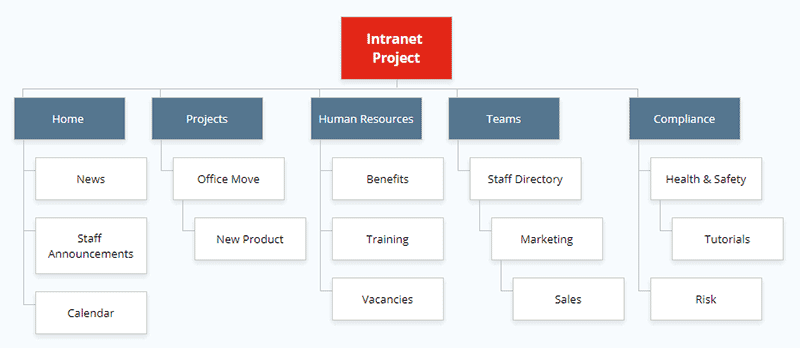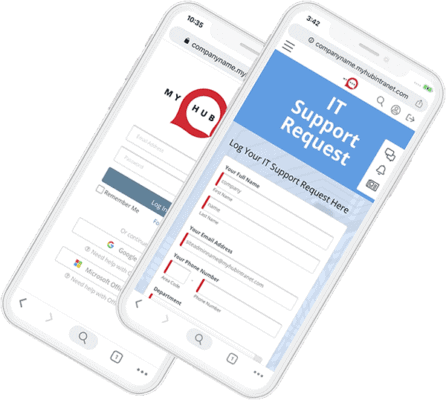
Your New Intranet Starts Here
Streamline communication, boost collaboration, and empower your team with MyHub's intuitive intranet solution.
Book a live demo now and experience the difference.
Take a Quick TourGetting Started With Your Intranet Implementation
Getting started on an intranet implementation may feel daunting – especially if you’re not entirely confident with technology. However, launching a modern intranet doesn’t require advanced tech skills when you have the right plan in place.
The same applies if you’re reviewing an existing platform. Whether you’re upgrading your current setup or starting fresh, the key to success is having a well-defined intranet roadmap. This strategic tool provides clarity, sets expectations, and ensures everyone involved is working toward the same goals. By breaking the project into manageable phases, you can simplify the entire process and reduce the risk of overwhelm.
In this blog post, we’ll guide you step-by-step through everything you need to know to create a successful intranet roadmap. By the end, you’ll feel empowered to move forward with confidence on your digital workplace project.
Buckle in – we’re getting started!
What Is an Intranet Roadmap?
An intranet roadmap is a strategic blueprint that outlines the vision, goals, and timeline for your intranet project. It helps answer the critical questions of what, why, how, and when. Often presented in a visual format, it provides a high-level view of your implementation journey.
Regardless of the format, a solid intranet roadmap usually includes the following core elements:
- Overall vision for the intranet’s purpose and long-term goals
- Key milestones that mark progress throughout the project
- Dedicated workstreams such as design, governance, and content management
- Timeline and budget for development and deployment
- Success metrics and measurable outcomes
- Plan for future upgrades, scalability, and performance reviews
Beyond just project management, your roadmap plays a crucial role in internal communications. It ensures stakeholders stay aligned, enables effective collaboration across departments, and offers a strategic foundation for deeper planning.
Remember: implementing an intranet isn’t only about the tech. Teams from HR, marketing, operations, and beyond will all contribute – from generating intranet content to employee onboarding and training. An effective roadmap helps all these moving parts function as one.
Building the Foundation: Vision and Ownership
The first step in your intranet roadmap is to define a clear vision. Ask yourself: What problems are we solving with the intranet? What specific outcomes are we aiming for? Are we seeking to enhance employee communication, reduce email clutter, streamline workflows, or better support remote teams?
For existing intranets, this step includes identifying current strengths and weaknesses. What’s working well? What’s outdated or underused? Are employees engaging with the platform or ignoring it entirely?
Establishing defined goals helps inform the structure of your project and keeps everyone focused. Once your vision is set, maintain an open dialogue with your team. Conduct surveys, run feedback sessions, or introduce a digital suggestion box to gather input. Employees are more likely to adopt the intranet if they feel involved in its creation.
Appoint a cross-functional intranet steering committee made up of representatives from different departments. This group offers valuable insights and helps promote organizational buy-in. They’ll also act as champions during the rollout phase, encouraging adoption within their teams.
Finally, identify a single point of accountability: a project lead or intranet owner. This is typically a senior leader with both the authority to make key decisions and the ability to mobilize resources. This person will drive the project forward and resolve any roadblocks that arise.
Why a Strategic Roadmap Sets You Up for Success
Too many intranet projects fail due to a lack of structure, direction, or long-term planning. A carefully thought-out roadmap ensures that your intranet isn’t just another unused tool – but a vital part of your digital workplace strategy.
In short, your roadmap is your guiding star. It keeps your goals in focus, your teams aligned, and your project on time and within budget.
Intranet Roadmap: Key Milestones and Essential Workstreams
Once you’ve identified the critical tools and features your intranet needs, it’s time to dive into the detailed planning phase. Defining clear milestones and organizing project workstreams ensures your intranet implementation stays on track and meets business objectives.
Deciding the level of detail in your intranet roadmap depends on your organization’s size and complexity. Some businesses prefer a high-level overview, while others include specific, interdependent workstreams. Regardless, your main roadmap will usually be supported by several detailed project plans tailored to each area.
Below are the most common intranet workstreams found in successful intranet projects:
Intranet Site Map
A comprehensive site map helps you structure all the pages and content within your intranet. It provides a visual overview that highlights potential duplications and ensures your navigation is logical and user-friendly.
Plan collaborative workshops with your intranet steering group to define the content hierarchy and navigation flow. A free and intuitive tool to visually map your intranet structure is Gloomaps, perfect for fast, clear site planning.
Intranet Design
Designing your intranet involves more than just aesthetics; it includes page layouts, intuitive navigation, branding, colors, and fonts to create a seamless user experience. While this might sound complex, it can actually be the most enjoyable stage of the project.
With platforms like MyHub, no advanced coding or specialist design skills are needed. You simply drag and drop content into place. If you’re short on time, MyHub’s team of intranet design specialists can deliver a polished, professional intranet quickly and efficiently.
Intranet Templates
Many intranet platforms, including MyHub, offer a rich library of pre-built templates designed to speed up deployment. These ready-made templates cover common business processes like leave requests, IT support tickets, and incident reporting.
Templates are fully customizable and designed for ease of use, making them ideal for non-technical users and ensuring your intranet can adapt as your business evolves.
Intranet Governance: Roles and Responsibilities
Your intranet won’t run itself. Establishing clear governance policies is essential to define who is responsible for content creation, editing, publishing, and overall management.
Assigning specific roles and permissions ensures content remains accurate, up-to-date, and relevant. A solid governance framework helps maintain the integrity of your intranet and encourages accountability across teams.
Intranet Pilot Program
Before a full launch, conduct an intranet pilot to test the platform in a controlled environment. Piloting allows you to identify and fix technical glitches, gather valuable user feedback, and verify the software meets your business needs.
Run the pilot with a select team or by location, ideally for around two weeks. Review feedback carefully and make necessary adjustments early on – this saves time and headaches after a company-wide rollout.
Intranet Launch Strategy
To ensure your intranet hits the ground running, involve your marketing team during launch. Build excitement with countdowns, launch events, and interactive content like quizzes and surveys to engage users from day one.
Encourage adoption by appointing intranet ambassadors or super-users within each team. These champions provide frontline support, answer questions, and help troubleshoot common issues.
Intranet Training Program
Successful intranets are supported by ongoing training programs. Post-launch training is critical to boost user adoption and help employees maximize the intranet’s benefits.
Training doesn’t have to be expensive or classroom-based. Leverage your intranet ambassadors as peer trainers, create simple how-to videos, or run short workshops. Demonstrate practical tasks like submitting a leave request or updating their staff directory profiles to make training relatable and hands-on.
Critical Intranet Roadmap Milestones for Project Success
Use your intranet roadmap to clearly identify all the significant milestones leading to a successful implementation. However, it’s important to keep the roadmap focused at a high level. Overloading it with too many tasks and minor milestones risks turning it into just another complex project plan. Instead, prioritize the critical milestones that truly drive progress and keep your team aligned on the main goals.
Intranet Roadmap Timeline: Clear Implementation Schedule
An essential component of the roadmap is the overall timeline for implementation. This timeline sets expectations and provides a clear framework for all the interdependent workstreams and tasks that contribute to the intranet’s delivery. A well-defined timeline helps manage deadlines and resource allocation, keeping the project on track from start to finish.
Defining Intranet Roadmap Outcomes and KPIs for Success Measurement
How will you determine if your intranet implementation has truly been successful? This part of the roadmap must clearly define the success criteria and establish measurable key performance indicators (KPIs) to evaluate impact and adoption.
Typical KPIs to consider include:
- Number of daily users and average session duration
- Percentage of staff reporting that the intranet saves time in their daily work
- Employee feedback confirming the intranet has improved productivity
- Percentage of staff agreeing the intranet helps them work more efficiently
- Content popularity metrics such as page views, comments, and most frequently used tools
These metrics provide valuable insight into your intranet’s effectiveness and user engagement, enabling continuous improvement.
Ongoing Intranet Roadmap Review and Governance Mechanisms
The intranet go-live date is just the beginning of a continuous journey, not the endpoint. Your roadmap must outline how the intranet will be handed over to the business for ongoing management and improvement.
Will the intranet steering group remain involved to ensure the project stays aligned with business goals? What processes will be in place for regular content reviews and functionality updates? Defining clear review mechanisms in the roadmap sets realistic expectations and keeps all stakeholders informed and engaged throughout the intranet’s lifecycle.
Intranet Roadmap Example: Blueprint for Your Project
Wondering what a practical intranet roadmap looks like? Below is a blueprint example to help you get started. While the exact details will vary depending on your organization’s needs, this framework covers the essential components and milestones to guide your intranet project from vision to launch and beyond.
| Responsibility | Workstream & Milestones | Dependencies / Outcomes | Timeline & Budget |
| Intranet Owner/Steering Group | Aims & objectives
Intranet software & provider selection Intranet governance Intranet launch Intranet training program Success criteria Review process |
Staff surveys
Research Consultation/focus groups Scalability KPIs Metrics |
By xx
Budget $x
By xx Budget $x |
| Intranet provider (such as MyHub) | Intranet templates
Intranet design Intranet pilot |
Site creation, site map, navigation, branding, visuals | |
| Team Administrators/Leaders | Content best practices
Content creation Review mechanisms & process for updating of content |
Create & update content
Review pages, functionality, aims & objectives to ensure intranet remains fit for purpose |
By XX
Budget $x Review content quarterly with annual assessment of intranet overall Budget $x |
Cloud, Custom-Built, or Off-the-Shelf Intranets: Which Is Right for Your Business?
When choosing an intranet solution, it’s crucial to explore all the options to find the best fit for your organization’s unique needs. A custom-built intranet involves developing a completely bespoke platform from scratch. This approach requires substantial IT expertise, a significant investment of time and resources, and ongoing maintenance commitment.
On the other hand, off-the-shelf intranets often leverage popular open-source software like WordPress. While these solutions can be cost-effective initially, the base free offerings are limited. To unlock full functionality, many plugins and add-ons are needed, which can quickly increase costs and add complexity, making management more challenging over time.
Cloud-based intranets are currently the favored choice among small and medium-sized businesses. These platforms use pre-built, customizable templates hosted securely by specialist intranet providers. Although multiple businesses may use the same base platform, customization options allow you to create a tailored and professional intranet solution that meets your specific requirements.
Key advantages of cloud intranets: They are easy to set up and manage without requiring extensive technical knowledge. Cloud intranets are also cost-effective, provide reliable high uptime, and include robust online security managed by the provider, removing the burden from your IT team.
It’s essential to thoroughly research all intranet options. Investigate what other companies in your industry are doing, request demos from potential providers, review customer testimonials, and consult trusted third-party product reviews to make an informed decision.
Intranet Roadmap Summary: Your Guide to Success
An intranet roadmap is a powerful tool that provides a broad vision and clear sense of direction for your project. It helps to establish clarity of purpose and manage expectations among all stakeholders, making the entire implementation process more streamlined and manageable.
If you are planning to implement or upgrade your intranet, don’t hesitate to get in touch. Explore MyHub’s Steps To Success, which outlines the typical process and timeline for launching a successful intranet. One of our expert intranet design consultants will guide you every step of the way, sharing best practices and helping you achieve your desired outcomes.
Contact us today for a free demo or start a no-obligation 14-day trial to explore the full possibilities of a modern, effective intranet tailored to your business.
FAQ Section
What is an intranet roadmap?
An intranet roadmap is a strategic plan that outlines the vision, objectives, milestones, and workstreams involved in implementing an intranet.
MyHub Intranet Solutions
Why is an intranet roadmap important?
It provides clarity, aligns stakeholders, and breaks down the project into manageable steps, ensuring a smooth and successful implementation.
What are common components of an intranet roadmap?
Key components include the overall vision, project milestones, workstreams like design and content creation, implementation timeline, and success measures.



